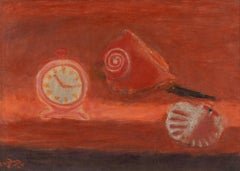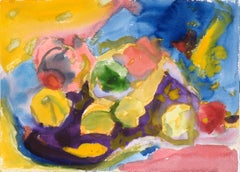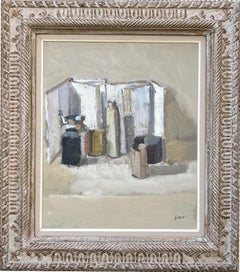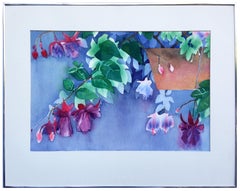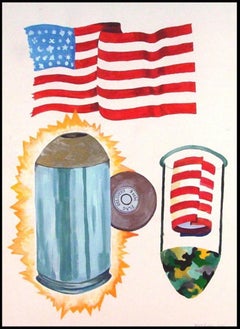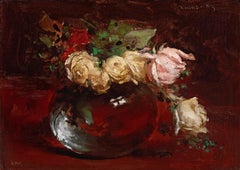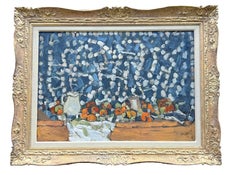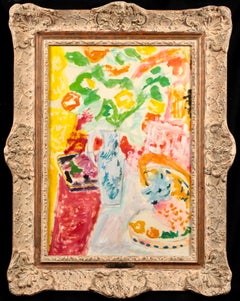Laid Paper Still-life Paintings
to
3
1
2
3
Overall Width
to
Overall Height
to
5
1
1
3
1
2
1
1
1
4
2
2
2
1
1
1
1
892
13,419
10,173
6,379
5,892
1
1
1
3
4
2
Medium: Laid Paper
Coquillage et réveil en rouge by Henri Hayden - Still Life Painting
By Henri Hayden
Located in London, GB
Coquillage et réveil en rouge by Henri Hayden (1883-1970)
Oil on paper laid down on isorel
33.5 x 46 cm (13 ¹/₄ x 18 ¹/₈ inches)
Signed and dated lower le...
Category
1960s Modern Laid Paper Still-life Paintings
Materials
Masonite, Oil, Laid Paper
Abstract Still Life with Fruit in Watercolor on Paper
By Les Anderson
Located in Soquel, CA
Abstract Still Life with Fruit in Watercolor on Paper
Colorful still life with fruit by Les (Leslie Luverne) Anderson (American, 1928-2009). Several pieces of fruit appear to be sitting on a table with a purple cloth. The scene is highly abstracted, straddling the line between impressionism and non-representational. The background is brightly colored, adding vibrancy to the scene.
Signed on verso and acquired from the estate of Les Anderson in Monterey, California.
Unframed.
Paper size: 14"H x 20"W
Les (Leslie Luverne) Anderson(American, 1928-2009) owned and operated the Bear Flag Gallery in San Juan...
Category
1980s Abstract Impressionist Laid Paper Still-life Paintings
Materials
Watercolor, Laid Paper
$380 Sale Price
20% Off
Still life with open books – Original Oil paint – 26 x 21.7 in
Located in Montfort l’Amaury, FR
"A contemplative homage to Morandi, where form, silence, and substance merge in quiet harmony."
Pierre Coquet (1926–2021)
Still life with open books
Oil on paper laid on board, 66 x...
Category
1980s French School Laid Paper Still-life Paintings
Materials
Oil, Laid Paper
Hanging Fuchsia Still-Life
Located in Soquel, CA
Beautiful still-life painting of fuchsias in a hanging basket by Rose Sloan (American, b.1941). Signed and dated "Rose Sloan '82" lower right. Presented in a metal frame and shipped without glass. Image, 13"H x 20"L.
Rose Sloan graduated in 1962 with a degree in Art Education from the University of Utah. Sloan now resides in Monterey, California where she teaches art classes and primarily paints plein-air paintings and still lifes.
Category
1980s American Impressionist Laid Paper Still-life Paintings
Materials
Watercolor, Laid Paper
$279 Sale Price
30% Off
Vintage Yellow & Red Roses Watercolor Still Life
Located in Soquel, CA
Beautiful painterly style watercolor still life of yellow roses mixed with red buds by Mary Alice Hinman (American, 1930-2012), c.1990s. Signed "M.A. Hinman" lower right. Image, 10.5...
Category
1990s American Impressionist Laid Paper Still-life Paintings
Materials
Watercolor, Laid Paper
$340 Sale Price
20% Off
DELIVERY, NINE MILLIMETER FLAG, 2001 Gouache Painting
By Marc Roder
Located in Surfside, FL
Marc Roder
Education
1991 MFA Painting, University of Pennsylvania
1985 BA Fine Art, University of California, Santa Cruz
1984 San Francisco Art Institute
Shows, Awards and teaching activities
2012 “Apparitions and Visitations”. Solo show, Lake George Arts Project, Lake George, NY
“Pastoral Visions”. Two person show, Gallery HOMELAND, Portland, OR
2011 Finalist, Betty Bowen Award, Seattle Art Museum.
2010 “Nouveau Frankenstein”. Three person show with Michael Campbell, Professor, University of Lethbridge and Scot Bullick, Alberta College of Art and Design.
Trianon Gallery, Lethbridge, Alberta, Canada
View Art Gallery, Group show, Victoria, BC
2009 Arts Council grant recipient: Solo show, ARC Gallery, April 2009. Hornby Island, BC
“Collectors Select…” Group show, La Grande, OR
Visiting Guest Artist/ Lecturer, Emily Carr University, North Island College, Courtenay, BC
2008 Visiting Guest Artist/ Lecturer, Emily Carr University, North Island College, Courtenay, BC
2007 “Parallax Views”. Group show, Greene Contemporary, Sarasota, FL
ArtBasel Miami, “Breaking the Waves”. Group show, Dorsch Gallery, Miami, FL
2006 Visiting Artist and Studio Critic, Notre Dame de Namurs University, Belmont, CA
Art Basel Miami, Group Show, Dorsch Gallery, Miami, FL
“Chopped Liver.” Solo show, Dorsch Gallery, Miami, FL
2004 “Northern Map and Bindle”. Solo show, Dorsch Gallery, Miami, FL
2003 “Miami Valise”. Traveling show, Vancouver B.C. and Miami, FL
2000 Florida Biennial. Ringling Museum of Art, Sarasota, FL
1999 “Fans”. Invitational group show, Ringling Museum of Art, Sarasota, FL
1998 “For the Birds”. Group show, Bucheon Gallery, San Francisco, CA
1997 “Inventories and Obsolete Designs”. Solo show, Betty Feves...
Category
Early 2000s Pop Art Laid Paper Still-life Paintings
Materials
Gouache, Laid Paper
Related Items
Abstract Painting of Shells
Located in Houston, TX
Small size watercolor image of shells. Painting is mainly blue, yellow and brown tones. Painting is framed in a painted wooden gold frame with a yellow matte.
Dimensions without Fram...
Category
1950s American Impressionist Laid Paper Still-life Paintings
Materials
Watercolor
Still Life
Located in Bryn Mawr, PA
John White Alexander's graceful depictions of beautiful women earned him critical acclaim both in Europe and America. However, his career did not get off to an easy start—Alexander b...
Category
1880s American Impressionist Laid Paper Still-life Paintings
Materials
Canvas, Oil
Contemporary impressionist expressive acrylic floral bouquet vase painting
Located in VÉNISSIEUX, FR
This captivating floral artwork "Summer blooming flowers in a blue vase" is an exuberant portrayal of a bouquet, radiating vibrancy and textural complexity. The piece commands attention with its vigorous brushstrokes, creating a sense of movement and depth.
The bouquet is composed of blooming flowers in a rich palette of colors ranging from various shades of pinks and purples to luminous whites. Each flower is rendered with bold, gestural layers of paint, creating a tactile surface that invites the viewer to appreciate the artist’s dynamic technique.
The background, with its harmonious blend of cool blues and popping greens, forms a vivid contrast against the warm tones of the flowers, enhancing their visual impact.
Noteworthy is the blue-checkered vase...
Category
2010s Abstract Impressionist Laid Paper Still-life Paintings
Materials
Acrylic, Watercolor, Paper
$296
H 11.62 in W 8.27 in D 0.04 in
«The sun in my house. Sun in the glass jars» Original vertical still life.
Located in Oslo, NO
This captivating artwork presents a still life composition of various jars and kitchen items placed on a reflective surface by a window. Bathed in soft, natural light, the glass jars...
Category
2010s American Impressionist Laid Paper Still-life Paintings
Materials
Paper, Oil, Acrylic
$948
H 39.38 in W 27.56 in D 0.04 in
Vibrating Corals, Colorful Reef Shapes, Vertical Seascape, Ilustration Style
Located in Barcelona, ES
Vibrating Corals captures the rich diversity and texture of underwater coral life. The artist uses confident lines and bold, layered colors—reds, blues, yellows, purples, and earthy ...
Category
2010s Naturalistic Laid Paper Still-life Paintings
Materials
Paper, Acrylic, Gouache
American Winter Landscape with Sun Glow. 'Lights and Shadows of Evening'.
Located in New York, NY
American landscape with sunny glow by American Artist Harry F. Waltman (1871 - 1951).
The painting shows a bright sunny winter landscape during sunset. Hints of warm tones reflect o...
Category
20th Century American Impressionist Laid Paper Still-life Paintings
Materials
Oil
Nocturnal Nature (Painted Still Life Cyanotype of Colorful Flower on Indigo)
Located in Hudson, NY
Hand-painted cyanotype still life of colorful flowers and plans on indigo background
Nocturnal Nature (Leaves, Snowdrops, Hibiscus, Ferns, Pollinators) — painted cyanotype by Julia W...
Category
2010s Contemporary Laid Paper Still-life Paintings
Materials
India Ink, Watercolor, Gouache, Archival Paper
$4,150
H 22 in W 28 in D 2 in
Botanical Studies, Watercolours on Silk on Handmade Paper, Set of Three Tulips.
Located in Cotignac, FR
A set of three fine hand painted botanical watercolour studies on silk of tulips by La Roche Laffitte. The works are signed bottom right. Some are titled and numbered (see photos) Th...
Category
Late 20th Century Laid Paper Still-life Paintings
Materials
Watercolor, Gouache, Handmade Paper, Silk
$1,346 Sale Price
20% Off
H 21.19 in W 15.16 in D 0.04 in
"Pink, " Acrylic Painting
Located in Denver, CO
Brian Sostrom's (US based) "Pink" is an original, handmade acrylic painting that depicts a fluffy cumulus cloud floating above the landscape, glowing pink and purple from the sun.
...
Category
2010s American Impressionist Laid Paper Still-life Paintings
Materials
Acrylic, Panel
From the cycle LYRICAL Fire, 41.5×29.5cm, gouache, paper, razor
Located in Yerevan, AM
From the cycle LYRICAL Fire, 41.5×29.5cm, gouache, paper, razor
Category
2010s Laid Paper Still-life Paintings
Materials
Paper, Gouache
$375 Sale Price
25% Off
H 16.34 in W 11.62 in
Wicket basket with Anemones a humble festive gift 19th century floral still life
Located in Norwich, GB
A charming 19th Century painting of Anemone flowers in a wicker basket. It has a warm, seasonal and festive feel. I love the great simplicity and sincerity it exudes. French in origi...
Category
Late 19th Century French School Laid Paper Still-life Paintings
Materials
Canvas, Oil
$800
H 18.12 in W 21.26 in D 1.19 in
"Shelter Island Yacht Club"- Oil painting, impressionis sailboats at rest in sun
Located in Sag Harbor, NY
“Shelter Island Yacht Club” is an oil painting by Kelly Carmody. It depicts sailboats at rest alongside a dock in full sun. A yellow under-tone peeks through, creating an overall war...
Category
21st Century and Contemporary American Impressionist Laid Paper Still-life Paintings
Materials
Oil, Panel
Previously Available Items
Still Life with Blue and White Fabric – Original Oil paint – 25.6 x 36.2 in
Located in Montfort l’Amaury, FR
"Inspired by Matisse and Bonnard, this still life celebrates expressive color and the elegance of the everyday."
Pierre Coquet (1926–2021)
Still Life with Blue and White Fabric
Oil ...
Category
Late 20th Century French School Laid Paper Still-life Paintings
Materials
Oil, Laid Paper
H 25.6 in W 36.23 in D 3.15 in
Bouquet de Fleurs aux Orange- Fauvist Still Life Oil Painting by Jules Cavailles
Located in Marlow, Buckinghamshire
Signed fauvist still life oil on paper laid on panel circa 1960 by French painter Jules Cavailles who was part of a group of artists called "La Realite Poetique". This charming piece depicts a blue vase filled with yellow and orange flowers.
Signature:
Signed with cachet lower left
Dimensions:
Framed: 23.5"x18"
Unframed: 17.5"x12"
Provenance:
The sale of the artists estate - Millon, Paris 2016
Born 20 June 1901, in Carmaux (Tarn); died 29 January 1977, in Epigneul (Yonne).
While working as a draughtsman in Carmaux, Jean Jules Louis Cavaillès...
Category
Mid-20th Century Fauvist Laid Paper Still-life Paintings
Materials
Oil, Panel, Laid Paper
Mary Vernon Morgan ARBSA, Still Life In An Upland Landscape, Antique Watercolour
Located in Cheltenham, GB
This early 20th-century watercolour by British artist Mary Vernon Morgan (1846-1927) depicts an abundant display of flora nestled into an upland landscape.
Set before a jagged rock, a myriad of wildflowers bloom in beauteous colours. Perhaps oxeye daisies...
Category
Early 1900s Naturalistic Laid Paper Still-life Paintings
Materials
Watercolor, Laid Paper
Skull and Mask
Located in Wilton Manors, FL
DOMENIC CRETARA
1946-2017
Skull and Mask, 1986. Oil on gessoed wove paper. Sheet measures 30 x 23 inches. Framed piece measures 37 x 30 inches. Original gallery label affixed on verso.
Domenic Cretara, Professor of Art at California State University, Long Beach, works primarily in drawing and painting. He earned his bachelor’s and master’s degrees from Boston University School of Fine Arts, graduating with honors. In his academic position at CSULB, he has received marks of distinction for teaching, scholarship, and creative achievement. Among other tributes, in 1974 he received a Fulbright Grant to Italy which allowed him to spend a year painting and studying in Florence. In the late 1970s, he was the artist in residence at the Foundation Camargo in Cassis, France. A Sister Cities Grant allowed him to return to work in Italy for a summer in the city of Padua.
As an artist, Cretara has been a particularly active exhibitor, with many solo exhibitions, including a retrospective at the Las Vegas Art Museum (1998), and over twenty-five group shows in venues on both coasts and Europe. His works are in the collections of major institutions such as the Metropolitan Museum of Art and the Art Institute of Boston. Cretara’s images not only have graced the covers of magazines and illustrated poems but have also been the subject of many publications, including Portrait Painting Atelier (Watson Guptill Publications, 2010) and Sex: Portraits of Passion (Watson Guptill Publications, 1999), feature articles for American Arts Quarterly and American Artist, and reviews in the Los Angeles Times and Boston Herald.
Education
1968-1970 Boston University School of Fine Arts, MFA
1964-1968 Boston University School of Fine Arts, BFA (Magna Cum Laude)
Solo Exhibits
2014 Schomburg Gallery, Santa Monica, CA
2014 Stone Rose Gallery, Long Beach, CA
2013 Triton Art Museum, Santa Clara, CA
2011 Schomburg Gallery, Santa Monica, CA
2009 Schomburg Gallery, Santa Monica, CA
2009 CSUIP Gallery, Florence, Italy
2008 Schomburg Gallery, Santa Monica, CA
2008 Todd Art Gallery, Middle Tennessee State University, Murfreesboro, TN
2002 Minneapolis College of Art and Design, MN
2002 Schomburg Gallery, Santa Monica, CA
2001 Frye Art Museum, Seattle, WA
1998 Las Vegas Art Museum, Retrospective Exhibit, Las Vegas, NV
1998 Martin Zambito Gallery, Seattle, WA
1997 Mulligan/Shanoski Gallery, San Francisco, CA
1996 Brenda Taylor Gallery, New York City
1995 Alon Gallery, Boston, MA
1993 The John Thomas Gallery, Santa Monica, CA
1992 Alon Gallery, Boston, MA
1991 The John Thomas Gallery, Santa Monica, CA
1989 Alon Gallery, Boston, MA
1988 Victor McNeil Gallery, New York City
1987 Koplin Gallery, Los Angeles, CA
1985 Segal Gallery, New York City
1984 Segal Gallery, New York City
Group Exhibits
2015 “Identity, Who Are We Now,” Minneapolis Institute of Art, Minneapolis, MN.
Exhibitors included Chuck Close, Robert Mapplethorpe, and Do Ho Suh.
Curator: Dennis Jon
2015 “Going Home,” Two-person traveling exhibit, Domenic Cretara and Chris
Troutman, Charleston Heights Art Center Gallery, Las Vegas, NV;
Schomburg Gallery, Santa Monica, CA; Sinclair Community College Art
Galleries, Dayton, OH.
2014 “The Way of Flesh Part 2”
Mt. San Antonio College Art Gallery, Walnut, CA.
2012 “The Figure in Contemporary Art”
Cypress College Art Gallery, Cypress, CA.
2006 “Beyond the Likeness: Self Portraits by California Artists,”
Triton Art Museum, Santa Clara, CA, Curator: George Rivera
2006 “A Terrible Beauty: Figurative Painting in the 21st Century,”
Grey McGear Modern Inc, Santa Monica, CA
Curator: Alec Aintree, Arts Critic The London Times
2005 “The Painted Image,” Biola University Art Gallery, La Mirada, CA
2005 “Las Vegas Centennial Invitational Exhibition,” Las Vegas Art Museum
2005 “Direct Access: an Exhibition of Drawings,”
Todd Art Gallery, Middle Tennessee State University, Murfreesboro, TN
2003 “Speculative Terrain,” The Carnegie Art Museum, Oxnard, CA.; The Riverside
Art Museum; The Laband Art Gallery. , Curator, Gordon Fuglie
2002 "Drawings VI," Koplin Gallery, Los Angeles, CA
2001 "Representing LA," Frye Art Museum, Seattle, WA; Art Museum of
South Texas, Corpus Christi, TX; Laguna Art Museum, Laguna, CA
Curator: Gordon Fuglie
2000 "Drawings V," Koplin Gallery, Los Angeles, CA
2000 "Drawing from Perception III," Wright State University Art Galleries
Dayton OH, Juror: Rosemary Beck...
Category
1980s Realist Laid Paper Still-life Paintings
Materials
Oil, Laid Paper
Mid Century Green Teapot Still-Life
Located in Soquel, CA
A beautiful still life oil painting of a green teapot next to a pear and persimmon on a red table by American Impressionist artist Genevieve Rogers. S...
Category
Mid-20th Century American Impressionist Laid Paper Still-life Paintings
Materials
Oil, Cardboard, Laid Paper
"IRIS" Cast Paper
Located in Soquel, CA
Cast paper piece by Wes ("Wess") Smith (American, b. 1958). Titled "IRIS" and signed along the bottom edge. Presented in a wood frame with a floating mat an...
Category
Late 20th Century Contemporary Laid Paper Still-life Paintings
Materials
Paint, Laid Paper
18 th Century French Botanical Watercolor Study of Raspberry Bramble
Located in SANTA FE, NM
French Botanical Watercolor Study of Raspberry Bramble
Watercolor, gouache on paper
18th century
9 1/4 x 7 inches
Stamp and notations at bottom from Collection Rougier, Paris, inscri...
Category
18th Century Naturalistic Laid Paper Still-life Paintings
Materials
Watercolor, Gouache, Laid Paper
Untitled: Still Life
By René Genis
Located in Berlin, MD
Rene Genis (French 1922-2004) Untitled: Still Life. Study of a white coffee pot on a table with melons and plums. The melons have a rich texture. Ov...
Category
Mid-20th Century Abstract Impressionist Laid Paper Still-life Paintings
Materials
Oil, Laid Paper
“Bouquet A La Marge Grise” Bouquet with the Grey Margin
By René Genis
Located in Berlin, MD
Rene Genis (French 1922-2004) “Bouquet A La Marge Grise” Bouquet with the Grey Margin. Oil on paper laid down on matt board. Muted colors of browns, burqundy, pink and greens highli...
Category
Mid-20th Century Abstract Impressionist Laid Paper Still-life Paintings
Materials
Oil, Laid Paper
H 30.75 in W 23.5 in D 1 in
Mid Century Art Deco Hawaiian Orchid Watercolor, Floral Study
Located in Soquel, CA
Wonderful vintage airbrushed watercolor of Hawaiian orchid. Signed lower right "Pierre Hawaii." One of the exceptional and successful Honolulu, Hawa...
Category
1940s Art Deco Laid Paper Still-life Paintings
Materials
Watercolor, Laid Paper
Bowl of Apples Still Life
Located in Soquel, CA
Wonderful watercolor of different colored apples by artist G. A. Brown (American, 20th Century), c. 1970. Signed lower right. Presented in gold tinted metal frame with mat. Shipped w...
Category
1970s American Impressionist Laid Paper Still-life Paintings
Materials
Watercolor, Laid Paper
Modernist Still Life
Located in Soquel, CA
Bright still life with bottles and jug by Diane Baldwin (American, 20th Century). Signed "Baldwin" bottom right. Unframed. Image size: 30"H x 22"W.
Category
1990s Modern Laid Paper Still-life Paintings
Materials
Watercolor, Laid Paper
Laid Paper still-life paintings for sale on 1stDibs.
Find a wide variety of authentic Laid Paper still-life paintings available on 1stDibs. While artists have worked in this medium across a range of time periods, art made with this material during the 21st Century is especially popular. If you’re looking to add still-life paintings created with this material to introduce a provocative pop of color and texture to an otherwise neutral space in your home, the works available on 1stDibs include elements of blue, red and other colors. There are many well-known artists whose body of work includes ceramic sculptures. Popular artists on 1stDibs associated with pieces like this include Victor Di Gesu, Henri Hayden, Carole Minou, and René Genis. Frequently made by artists working in the Impressionist, Abstract, all of these pieces for sale are unique and many will draw the attention of guests in your home. Not every interior allows for large Laid Paper still-life paintings, so small editions measuring 0.1 inches across are also available Prices for still-life paintings made by famous or emerging artists can differ depending on medium, time period and other attributes. On 1stDibs, the price for these items starts at $1 and tops out at $1,985,000, while the average work can sell for $2,198.
Recently Viewed
View AllMore Ways To Browse
Van Gogh Cafe Terrace
Sidney Pike
Silvestro Lega
Ski Gondola
Soviet Circus Poster
St James Vintage Lighting
Stanislavs Kreics
Stephen A Peters
Tallulah Bankhead Portrait
Ted Fontaine
Texas Windmill Paintings
Thanh Le
The Highwaymen Paintings
Tom Howard Watercolor
Toy Sailboat
Travis And Co
Used Dior Jordan 1
Used Water Rower
